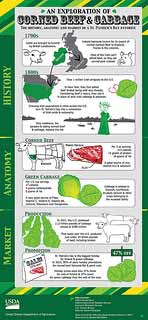Did you ever wonder how corned beef and cabbage became the signature dish of St Patrick’s Day? The U.S. Department of Agriculture (USDA) has put together a little history of the dish and has some food safety tips for how to prepare it.
 Corned beef gets its name from the large chunks or “corns” of salt used to cure it. In the 17th century the Irish used that method of curing meat for pork and adapted it for beef in the 17th century, when British land owners first brought cattle to Ireland. Although Ireland became known as an exporter of corned beef, most Irish people couldn’t afford to eat beef until the 18th century when they immigrated to America where salted beef brisket was inexpensive. Cabbage, which is rich in nutrients, was also inexpensive. Combining the two made a hearty, nutritious meal that quickly became a staple of working class Irish-Americans, according to the USDA.”As St. Patrick’s day evolved into a celebration of Irish heritage and nationality for Irish-Americans, corned beef and cabbage became a holiday tradition for consumers across the nation.”
Corned beef gets its name from the large chunks or “corns” of salt used to cure it. In the 17th century the Irish used that method of curing meat for pork and adapted it for beef in the 17th century, when British land owners first brought cattle to Ireland. Although Ireland became known as an exporter of corned beef, most Irish people couldn’t afford to eat beef until the 18th century when they immigrated to America where salted beef brisket was inexpensive. Cabbage, which is rich in nutrients, was also inexpensive. Combining the two made a hearty, nutritious meal that quickly became a staple of working class Irish-Americans, according to the USDA.”As St. Patrick’s day evolved into a celebration of Irish heritage and nationality for Irish-Americans, corned beef and cabbage became a holiday tradition for consumers across the nation.”
Statistics from the USDA’s Agricultural Marketing Service (AMS) show that St. Patrick’s Day was the “single largest promotional period for beef brisket cuts in 2012,” with prices an average of 21 percent lower than they are the rest of the year. Cabbage prices around St Patrick’s Day are almost 50 percent lower than they are the rest of the year.
If you are thinking about preparing corned beef for St. Patrick’s Day, remember that brisket is a tough cut of mat that needs to be cooked over along period of time for the best results. Read the the USDA’s complete safety tips on preparing corned beef and remember to use a meat thermometer to make sure the internal temperature has reached 145 degrees F before serving.




